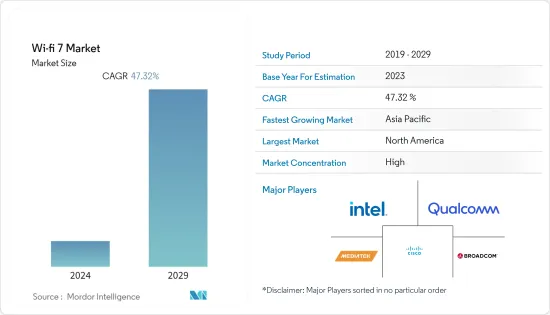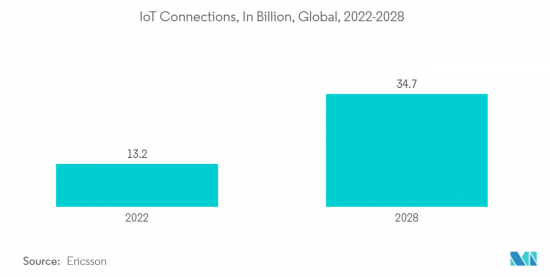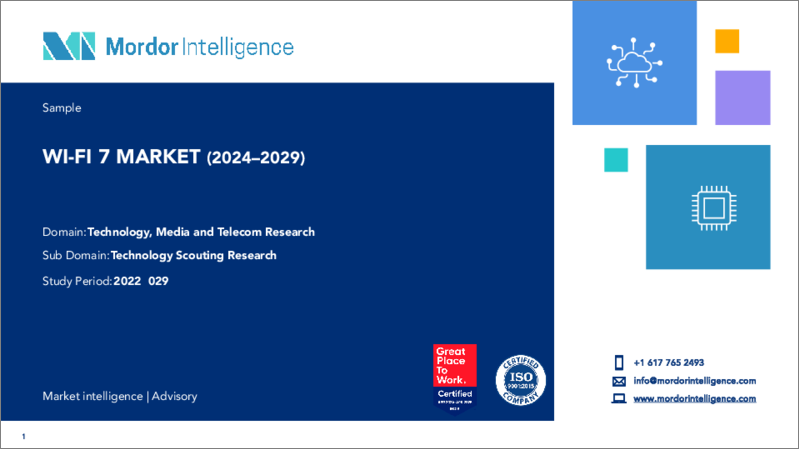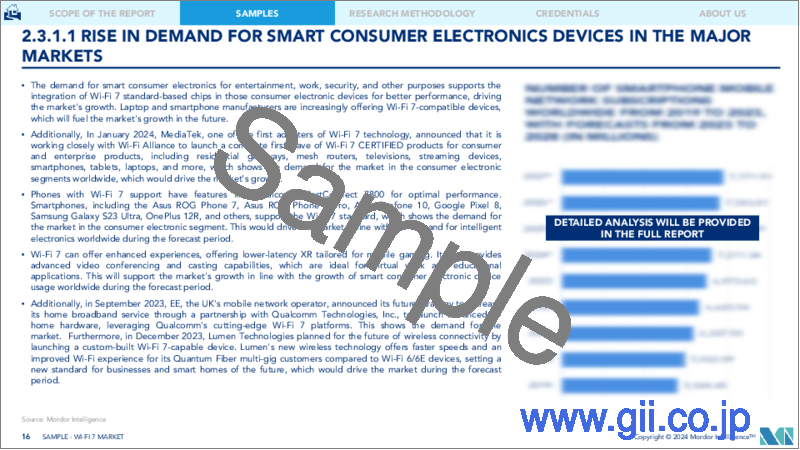|
|
市場調査レポート
商品コード
1408569
Wi-Fi 7-市場シェア分析、産業動向と統計、2024~2029年の成長予測Wi-fi 7 - Market Share Analysis, Industry Trends & Statistics, Growth Forecasts 2024 - 2029 |
||||||
カスタマイズ可能
適宜更新あり
|
|||||||
| Wi-Fi 7-市場シェア分析、産業動向と統計、2024~2029年の成長予測 |
|
出版日: 2024年01月04日
発行: Mordor Intelligence
ページ情報: 英文 120 Pages
納期: 2~3営業日
|
全表示
- 概要
- 目次
Wi-Fi 7の市場規模は今年度8億7,521万米ドルで、今後5年間で60億7,323万米ドルに達すると予測され、予測期間中のCAGRは47.32%です。

主要ハイライト
- Wi-Fi 7はIEEE標準802.11beとして知られています。2.4GHz、5GHz、6GHzなど複数の異なる無線周波数で動作します。最大速度4万Mビット/秒のリンクを提供します。16の空間ストリームとMIMO(Multiple Input Multiple Output)技術により、ビデオストリーミングの品質と解像度が向上しています。Wi-Fi 7の機能であるHARQ(Hybrid Automatic Repeat Request)は、複数のリンク適応を容易にします。
- IEEE 802.11beと呼ばれるIEEE 802.11規格の次期改訂版は、EHT(Extremely High Throughput)です。802.11axの上に、2.4、5、と6 GHzの周波数帯域で歩行者と定常速度で動作するWLAN屋内と屋外を強調します。速度は40GbpsのThunderboltに匹敵すると予想されています。
- 動画配信に必要なスループットは、4k/8k動画のイントロダクションよって数十Gbpsまで上昇し続けると思われます。オンラインゲーム、拡大現実(AR)、仮想現実(VR)、その他の新鮮で高スループット、低遅延のビデオアプリケーションも爆発的に増加しています。ワイヤレス・ローカル・エリア・ネットワーク(WLAN)上でこれらのアプリケーションをサポートすることは、関連する厳しい要件のため、最新のWLAN規格であるIEEE 802.11axの能力をはるかに超えています。
- IEEE802.11は、このような高まる要求を満たすために、新しい改正規格IEEE 802.11be-Extremely High Throughput(EHT)(しばしばWireless-Fidelity(Wi-Fi)7として知られる)を発表する予定です。eコマース取引、ウェブ閲覧、モバイル学習、その他のオンライン関連活動に従事する顧客が増加しており、より高速なインターネットアクセスへの需要が高まっています。その結果、ノートパソコンやPC、タブレット端末で頻繁に利用される無線LANルーターは、人間の生存に不可欠なものとなった。Wi-Fiルーターは、信頼できるインターネットに接続したいという消費者のニーズの高まりや、多くの国々でのWi-Fi接続の強化に大きく貢献しています。
- さらに、医療、教育、ビジネス、金融サービス、その他の用途で接続デバイスの使用が増加していることも、世界のWi-Fi 7市場の主要促進要因の1つとなっています。さらに、中小企業がデバイス持ち込み政策を採用することも、市場成長にプラスの影響を与えています。さらに、予測期間中、スマートシティプロジェクトに対する政府の取り組みが急増し、市場拡大の有利な機会が生まれると予測されています。
- コロナウイルス(COVID-19)の蔓延を抑えるために移動制限が実施されたため、経済協力開発機構(OECD)諸国の推定13億人の国民のうち、ますます多くの人々が自宅で仕事をしたり勉強したりするようになった。重要な国際政策の調整は、G7やG20のような場でオンラインで行われました。インターネットのバリューチェーン全体において、固定とモバイルのブロードバンド事業者、コンテンツとクラウドプロバイダー、そしてインターネット・エクスチェンジ・ポイント(IXP)と呼ばれるインターネット・ネットワークがトラフィックを交換するために接続するポイントでは、インターネット・トラフィックが発生前に比べて60%も増加しました。これらの要因は、パンデミック後のWi-Fi 7の需要にプラスの影響を与えました。
Wi-fi 7の市場動向
新興地域における屋外Wi-Fi導入に焦点を当てた進行中のスマートシティプロジェクト
- スマートフォンは消費者向け、企業向けを問わず、さまざまなアプリケーションで大量のデータを使用するため、柔軟性のある広帯域幅へのニーズが高まっています。技術の進化に伴い、市場ベンダーはより高いデータレート、低遅延、より優れたネットワーク容量に対するニーズの高まりを得ており、Wi-Fi 7のような先進技術にビジネスチャンスが生まれています。
- 2022年、国際電気通信連合(ITU)は、世界人口の66%にあたる53億人がインターネットを利用すると推定しています。これは2019年から24%の伸びを示し、その間に11億人がインターネットに参加すると予想されます。このようなインターネット普及率の上昇は、国内外のWi-Fi 7ベンダーにとって、主要市場シェアを獲得するために新製品を投入し、帯域幅を拡大する機会を大きく生み出すと思われます。
- 無料の公共インターネット・アクセスを提供することに加え、スマート・シティはWi-Fiを、交通の電子ルーティング、大気汚染の監視、水と接続の節約、安全を確保しながらの地元住民との協力など、さまざまな目的で利用しています。例えば、Wi-Fi接続は地元の人々にとっても観光客にとっても重要なアメニティになりつつあります。特に海外旅行で法外なローミング料金を避けたい観光客にとっては、ナビゲーションや観光への継続的なアクセスが不可欠となります。スマートシティの台頭は、市場に好影響をもたらすと思われます。
- アメリカ地域のさまざまな政府もスマートシティの導入を推進しており、Wi-Fi 7の採用も進んでいます。例えば、ラスベガスでは3つのパイロット・プロジェクトをテストしており、政府は2025年までに都市全体を接続する方法を見つけるために5億米ドルを割り当てています。政府によるスマートシティプロジェクトの増加は、Wi-Fiルーター市場の需要に影響を与えるもう一つの要因です。
- さらに、各国政府がスマートシティプロジェクトの拡大を支援していることも、同市場の主要動向となっています。インドでは住宅都市省の支援により、2023年までに人口500万人規模の都市を4,000都市整備することを目指しています。そのため、グラフにあるように、スマートシティによるIoTの拡大が、予測期間中にWi-Fi 7技術に大きな需要を生み出すと分析されています。

北米が市場で最大シェアを占めると分析
- 北米地域は、米国とカナダの2つの新興経済諸国で構成されています。同地域ではスマート工場の導入が拡大しており、これが北米市場の成長を促す主要要因となっています。Wi-Fiチップセット、産業用PC、ゲートウェイデバイス、PLC、産業用ロボット、ワイヤレスセンサーはすべて、スマート工場のシステムで幅広く使用されています。スマート工場におけるワイヤレス接続デバイスとIoTインフラの拡大により、Wi-Fi 7市場は高成長が見込まれています。
- 同地域では、省エネ・低排出ソリューションの需要により、スマートホームの採用が増加しています。国家の経済的繁栄に不可欠な要素はエネルギー効率です。地球温暖化の深刻化と政府による法規制の結果、同地域ではエネルギー使用と二酸化炭素排出を最小限に抑える需要が高まっています。スマートホームの機能にはスマートデバイスが必要であり、これが北米におけるWi-Fi 7のビジネスチャンスを生み出しています。
- さらに、多くの世界企業や地域企業が、同地域のスマートデバイスにそれらを統合するための先進的なWi-Fiチップセットを開発しています。例えば、2022年3月、アメリカのBroadcomは、1年間で5億個のWi-Fi 6/6Eチップのうち、10億個のWi-Fi 6/6Eチップを供給しました。同社は今後、必要に応じてWi-Fi 7チップセットを生産する予定です。
- 2022年8月、Qualcomm Technologiesは42億米ドルの追加支出を約束し、GlobalFoundriesの米国工場で生産される半導体チップに費やされる総額は74億米ドルに達しました。このうち同社との32億米ドルの契約は、5Gトランシーバー、Wi-Fi、自動車、モノのインターネット(IoT)向けチップを対象としています。Qualcommは、ウエハー供給を確保し、2028年末までにGlobalFoundriesのニューヨーク工場の生産能力を増強すると発表しました。
- カナダもWi-Fi用に6GHz帯を開放することを決定し、他の多くの国に加わった。ISEDによると、6GHz帯の周波数変更により、カナダ国民全体にとって最大のWi-Fi改善がもたらされます。業界では、Wi-Fi 6Eデバイスが最近発売されたばかりであるにもかかわらず、帯域幅がさらに大幅に増加するWi-Fi 7が2024年までに発売されると予想しています。これらの要因が、この地域におけるWi-Fi 7市場の成長に大きく寄与しています。
Wi-Fi 7産業概要
Wi-Fi 7市場の特徴は、市場シェアを大きく握る主要企業が集中していることです。これらの主要企業は、予測期間を通じて競合を維持するために複数の製品を積極的に投入しています。
2023年6月、Broadcom Inc.は、Wi-Fi 7エコシステム向けに調整された第2世代ワイヤレス接続チップセットソリューションのリリースと利用可能性に関する注目すべき発表を行った。これらのソリューションには、Wi-Fiルーター、企業向けアクセスポイント、住宅用ゲートウェイ、クライアント機器など、幅広い製品が含まれます。これらの新しいチップの特徴は、より幅広い顧客層に対応する機能性の強化です。さらに、これらのチップは、Broadcomの第1世代Wi-Fi 7の基盤の上に構築されているため、主要市場以外にもさまざまな市場で使用することができます。
2022年6月、Qualcomm Technologies, Inc.は、一流のWi-FiとBluetooth体験を提供するために設計された一連のRFFEモジュールを発表しました。この拡大ポートフォリオは、Bluetooth、Wi-Fi 6E、と今後のWi-Fi 7規格に対応しています。これらのモジュールは、スマートフォンだけでなく、車載、拡大現実(XR)、パーソナルコンピュータ(PC)、ウェアラブル、モバイルブロードバンド、モノのインターネット(IoT)など、多様なデバイスセグメントに対応するように設計されています。
Broadcom Inc.は2022年 4月、Wi-Fi 7エコシステム専用に設計された包括的なエンドツーエンドチップセットソリューションを発表しました。この包括的なラインアップは、Wi-Fiルーター、住宅用ゲートウェイ、企業向けアクセスポイント、クライアントデバイスをカバーします。特に、Broadcomの最新のWi-Fi 7チップセットは、320 MHzチャネルを提供することでWi-Fiチャネル帯域幅を倍増することが期待されています。この進歩は、6 GHz帯の世界のWi-Fiスペクトラムの拡大と完全に一致するため、市場にとって価値ある追加となります。
その他の特典:
- エクセル形式の市場予測(ME)シート
- 3ヶ月間のアナリストサポート
目次
第1章 イントロダクション
- 調査の前提条件と市場定義
- 調査範囲
第2章 調査手法
第3章 エグゼクティブサマリー
第4章 市場洞察
- 市場概要
- 業界の魅力度-ポーターのファイブフォース分析
- 買い手の交渉力
- 供給企業の交渉力
- 新規参入業者の脅威
- 代替品の脅威
- 競争企業間の敵対関係
- Wi-Fi規格と規制の進化
- 市場に影響を与えるマクロ経済要因
第5章 市場力学
- 市場促進要因
- 主要市場におけるスマート家電機器の需要増加
- 新興地域における屋外Wi-Fi導入に焦点を当てた進行中のスマートシティプロジェクト
- 市場抑制要因
- 高密度環境における運用上の課題
- 屋外エリアでの実装に関する懸念
第6章 市場セグメンテーション
- タイプ別
- ハードウェア
- アクセスポイント
- ゲートウェイ
- ルーターと中継器
- サービス別
- ハードウェア
- 用途別
- 屋内
- 屋外
- 地域別
- 北米
- 欧州
- アジア太平洋
- ラテンアメリカ
- 中東・アフリカ
第7章 競合情勢
- 企業プロファイル
- Intel Corporation
- Broadcom Inc.
- Cisco Systems Inc.
- Qualcomm
- MediaTek Inc.
- Huawei Technologies Co. Ltd
- TP-Link
- Rohde & Schwarz
- HFCL
- Netgear
第8章 投資分析
第9章 市場機会と今後の動向

The Wi-Fi 7 market market was valued at USD 875.21 million in the current year and is expected to reach USD 6073.23 million in the next five years, registering a CAGR of 47.32% over the forecast period.
Key Highlights
- Wi-Fi 7 is known as the IEEE standard 802.11be. It works with several different radio frequencies, including 2.4GHz, 5GHz, and 6GHz. It offers links at a maximum speed of 40,000 Mbit/s. The quality and resolution of video streaming are improved by 16 spatial streams and Multiple Input Multiple Output (MIMO) technology. Hybrid Automatic Repeat Request (HARQ), a feature of Wi-Fi 7, facilitates multiple link adaptation.
- The upcoming revision of the IEEE 802.11 standard, called IEEE 802.11be, is Extremely High Throughput (EHT). On top of 802.11ax, it will emphasize WLAN indoor and outdoor operating at pedestrian and stationary speeds in the 2.4, 5, and 6 GHz frequency bands. It is anticipated that the speeds will match Thunderbolt at 40 Gbps.
- The throughput needed for video distribution will continue to rise to tens of Gbps with the introduction of 4k/8k video. Online gaming, augmented reality (AR), virtual reality (VR), and other fresh, high-throughput, and low-latency video applications are also exploding. Supporting these applications over a wireless local area network (WLAN) is much beyond the capabilities of the latest WLAN standard, IEEE 802.11ax, because of the associated strict requirements.
- The IEEE 802.11 will publish a new amendment standard, IEEE 802.11be - Extremely High Throughput (EHT), often known as Wireless-Fidelity (Wi-Fi) 7, to satisfy these growing demands. A growing number of customers are engaging in e-commerce transactions, web browsing, mobile learning, and other online-related activities, driving the demand for faster internet access. As a result, the wireless router, frequently utilized in laptops, PCs, and tablets, has become essential for human existence. Wi-Fi routers are mostly responsible for the rising need among consumers to stay linked to dependable Internet and for enhancing Wi-Fi connections in numerous nations.
- Moreover, the increasing use of connected devices in healthcare, education, business, financial services, and other applications is one of the key drivers of the worldwide Wi-Fi 7 market. Additionally, the market growth is positively impacted by small and medium businesses adopting a bring your device policy. Further, during the projected period, a surge in government initiatives for smart city projects is anticipated to create lucrative opportunities for market expansion.
- As mobility restrictions were enforced to contain the spread of the coronavirus (COVID-19), more and more of the estimated 1.3 billion citizens of Organization for Economic Cooperation and Development (OECD) countries worked and studied from home. Critical international policy coordination was conducted online in fora, such as the G7 or G20. Along the entire Internet value chain, fixed and mobile broadband operators, content and cloud providers, and points where Internet networks connected to exchange traffic, called Internet exchange points (IXPs), experienced as much as 60% more Internet traffic than before the outbreak. These factors positively affected the demand for Wi-Fi 7 post-pandemic.
Wi-fi 7 Market Trends
Ongoing Smart City Projects Focused on Deployment of Outdoor Wi-Fi in Emerging Regions
- As smartphones have a combination of volume and heavy data usage across a wide variety of applications in both consumer and enterprise settings, the need for high bandwidth with flexibility is increasing. As technology evolves, market vendors have been getting the increased need for higher data rates, lower latency, and better network capacity, thus creating opportunities in advanced technologies such as Wi-Fi 7.
- In 2022, the International Telecommunication Union (ITU) estimated that 5.3 billion people, or 66% of the world's population, utilize the Internet. This marks a 24% growth from 2019, with an expected 1.1 billion people joining the Internet throughout that time. Such a rise in internet penetration will significantly create opportunities for local and international Wi-Fi 7 vendors to introduce new products and increase the bandwidth to capture the major market share.
- In addition to providing free public Internet access, smart cities use Wi-Fi for various purposes, including e-routing traffic, monitoring air pollution, conserving water and connection, and cooperating with locals while ensuring their safety. For instance, Wi-Fi connection is becoming a more important amenity for both locals and visitors. It can be vital for tourists who may want continual access to navigation and sightseeing, especially if they are traveling abroad and wish to avoid exorbitant roaming fees. The rise in smart cities will create a positive impact on the market.
- Various governments in the American region are also promoting the adoption of smart cities and, therefore, the adoption of Wi-Fi 7. For instance, Las Vegas is testing three pilot projects, with the government allocating USD 500 million to find ways to connect the entire city by 2025. The increase in the number of smart city projects undertaken by governments is another factor influencing the demand for the Wi-Fi router market.
- Further, national governments aiding the expansion of smart city projects is also a key trend in the market. With the help of the Ministry of Housing and Urban Affairs in India, the nation aims to develop 4,000 cities to house a population of 5,00,000 each by 2023. Therefore, as indicated in the graph, the growing IoT with the smart cities is analyzed to create significant demand for the Wi-Fi 7 technology during the forecast period.

North America is Analyzed to Hold Largest Share in the Market
- The North American region consists of two developed economies, the USA and Canada. The growing adoption of smart factories in the region is the primary factor driving the market growth in North America. Wi-Fi chipsets, industrial PCs, gateway devices, PLCs, industrial robots, and wireless sensors are all broadly used in the systems of smart factories. High-growth prospects are being created for the Wi-Fi 7 market by expanding wirelessly connected devices and IoT infrastructure in smart factories.
- Smart home adoption in the region is increasing due to the demand for energy-saving and low-emission solutions. An essential component of a nation's economic prosperity is energy efficiency. As a result of escalating global warming and governmental laws, there has been an increasing demand to minimize energy use and carbon emissions in the region. Smart homes need smart devices to be functional, which is creating an opportunity for Wi-Fi 7 in North America.
- Further, many global and regional companies are developing advanced Wi-Fi Chipsets to integrate those into the smart devices in the region. For example, in March 2022, Broadcom, an American company, supplied a billion Wi-Fi 6/6E chips, out of which 500 million Wi-Fi 6/6E chips were supplied in a year. The company will produce Wi-Fi 7 chipsets in the future according to the need.
- In August 2022, Qualcomm Technologies committed to spending an additional USD 4.2 billion, bringing the total amount spent on semiconductor chips produced at a US facility of GlobalFoundries to USD 7.4 billion, out of which the USD 3.2 billion contracts with the corporation cover chips for 5G transceivers, Wi-Fi, vehicles, and the Internet of Things (IoT). Qualcomm announced that it has secured wafer supply and pledges to increase the capacity of GlobalFoundries' New York factory by the end of 2028, which will drive the Wi-Fi-Chipset market in the region.
- Canada has also decided to open up 6GHz for Wi-Fi, joining many other nations. According to ISED, the largest Wi-Fi improvement for all Canadians would be brought about by the 6 GHz spectrum modification. The industry anticipates Wi-Fi 7 to launch by 2024 with still another significant increase in bandwidth, even though Wi-Fi 6E devices have only recently launched. These factors are significantly contributing to the Wi-Fi 7 market growth in the region.
Wi-fi 7 Industry Overview
The Wi-Fi 7 market is characterized by a significant concentration of major players who collectively hold a substantial market share. These key players are actively introducing multiple products to maintain their competitive edge throughout the projected period.
In June 2023, Broadcom Inc. made a noteworthy announcement regarding the release and availability of its second-generation wireless connectivity chipset solutions tailored for the Wi-Fi 7 ecosystem. These solutions encompass a wide range of products, including Wi-Fi routers, enterprise access points, residential gateways, and client devices. What sets these new chips apart is their enhanced functionality, catering to a broader customer base. Additionally, these chips are built on the foundation of Broadcom's original generation Wi-Fi 7, enabling their use in various markets beyond the primary one.
In June 2022, Qualcomm Technologies, Inc. unveiled a series of RFFE modules designed to deliver top-notch Wi-Fi and Bluetooth experiences. This expanded portfolio caters to Bluetooth, Wi-Fi 6E, and the upcoming Wi-Fi 7 standard. These modules are thoughtfully crafted to serve a diverse range of device segments, extending beyond smartphones to include automotive, extended reality (XR), personal computers (PCs), wearables, mobile broadband, Internet of Things (IoT), and more.
In April 2022, Broadcom Inc. announced the full availability of its comprehensive end-to-end chipset solutions designed specifically for the Wi-Fi 7 ecosystem. This comprehensive lineup covers Wi-Fi routers, residential gateways, enterprise access points, and client devices. Notably, Broadcom's latest Wi-Fi 7 chipsets are expected to double the Wi-Fi channel bandwidth by offering 320 MHz channels. This advancement aligns perfectly with the expanded global Wi-Fi spectrum in the 6 GHz band, making it a valuable addition to the market.
Additional Benefits:
- The market estimate (ME) sheet in Excel format
- 3 months of analyst support
TABLE OF CONTENTS
1 INTRODUCTION
- 1.1 Study Assumptions and Market Definition
- 1.2 Scope of the Study
2 RESEARCH METHODOLOGY
3 EXECUTIVE SUMMARY
4 MARKET INSIGHTS
- 4.1 Market Overview
- 4.2 Industry Attractiveness - Porter's Five Forces Analysis
- 4.2.1 Bargaining Power of Buyers
- 4.2.2 Bargaining Power of Suppliers
- 4.2.3 Threat of New Entrants
- 4.2.4 Threat of Substitutes
- 4.2.5 Intensity of Competitive Rivalry
- 4.3 Evolution of Wi-Fi Standards and Regulations
- 4.4 Macro Economic Factors Impacting the market
5 MARKET DYNAMICS
- 5.1 Market Drivers
- 5.1.1 Rise in Demand for Smart Consumer Electronics Devices in the Major Markets
- 5.1.2 Ongoing Smart City Projects Focused on Deployment of Outdoor Wi-Fi in Emerging Regions
- 5.2 Market Restraints
- 5.2.1 Operational Challenges in Denser Environments
- 5.2.2 Concerns Related to Implementation in Outdoor Areas
6 MARKET SEGMENTATION
- 6.1 By Type
- 6.1.1 Hardware
- 6.1.1.1 Access Points
- 6.1.1.2 Gateways
- 6.1.1.3 Routers and Extenders
- 6.1.2 Services
- 6.1.1 Hardware
- 6.2 By Application
- 6.2.1 Indoor
- 6.2.2 Outdoor
- 6.3 By Region
- 6.3.1 North America
- 6.3.2 Europe
- 6.3.3 Asia-Pacific
- 6.3.4 Latin America
- 6.3.5 Middle East and Africa
7 COMPETITIVE LANDSCAPE
- 7.1 Company Profiles
- 7.1.1 Intel Corporation
- 7.1.2 Broadcom Inc.
- 7.1.3 Cisco Systems Inc.
- 7.1.4 Qualcomm
- 7.1.5 MediaTek Inc.
- 7.1.6 Huawei Technologies Co. Ltd
- 7.1.7 TP-Link
- 7.1.8 Rohde & Schwarz
- 7.1.9 HFCL
- 7.1.10 Netgear





